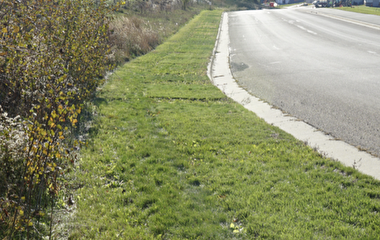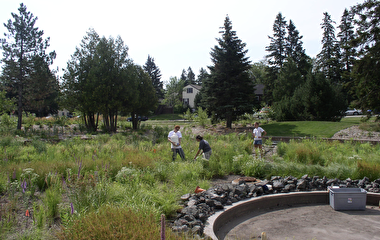“Green alleys” provide small patches of green space in urban areas. The alleys, which usually incorporate vegetation, can help prevent environmental degradation by controlling stormwater runoff. For her master’s thesis, U of M graduate Ella Weber explored whether intentionally greened “blooming alleys” can also benefit neighborhood well-being and residents’ mental health. Her advisor was Professor Ingrid Schneider of the Department of Forest Resources.
For her work, Weber reviewed previous studies that analyzed the health benefits of larger natural spaces. Research has consistently found that exposure to nature can reduce mental fatigue, she says, and urban parks and greenways provide opportunities for restorative nature experiences. The benefits of small-scale green spaces, however, are relatively unstudied.
During the summer of 2019, Weber conducted two focus groups and 22 interviews with Minneapolis residents living adjacent to green alleys, aiming to determine whether these public health benefits translate to smaller spaces. She then identified themes from participants’ direct quotes and actions and coded responses based on characteristics from an attention-restoration theory, mentions of stress, and aesthetic preferences.
Prominent in the responses were feelings of “fascination” (with details such as plant diversity or pollinators) and “compatibility” (a sense of belonging in an environment). Residents also reported restorative experiences during both purposeful interactions with the green alleys, such as gardening, and incidental experiences, such as taking out the trash.
“Although individuals did not place an emphasis on specific mental health impacts,” Weber says, “their mention of factors known to contribute to mental well-being provides strong indication that green-alley residents receive benefits whether or not they are actively aware of them.”
In 2012, the World Health Organization expanded its public health framing to include health disparities tied directly to urbanization, Weber notes. Urbanization decreases connections to nature while increasing stressors from pollution, strenuous commutes, and sedentary work environments.
Weber suggests further studies might be warranted; measurements of cortisol levels in response to green space might give more specific results, for example. Still, she concludes that a “small dose of nature provided by small-scale green spaces can have a meaningful impact on human health.” The findings could be used to inform best practices in urban planning and design.
Metro Blooms, a Minneapolis nonprofit, spearheaded the initial project in the Lake Nokomis neighborhood in 2014. The nonprofit partners with communities to create resilient landscapes and foster clean watersheds.
Weber is now a public lands transportation fellow with the US Fish & Wildlife Service. Her research was published in the journal Urban Forestry & Urban Greening, issue 57 (2021).
Writer: Sophie Koch


